This is now a read-only archive, and will likely be pulled down in a year or so.
For the MF3D comment site, please visit https://folio.solidsight.net/
This is now a read-only archive, and will likely be pulled down in a year or so.
For the MF3D comment site, please visit https://folio.solidsight.net/
In “full confession” mode, I’m here to tell you I have nothing new to offer. I have not made a single image since the Before Times. That’s more than three years without loading the camera, finding the scenes, composing the image, and tripping the shutter. It is a dissatisfying mental place to be, but I just haven’t wanted to create any images.
So from this melancholic zone, I’m reaching into my box of treasures to offer you some images from those whose work has inspired me, and from whom we will be seeing no new images. I’ll try to have some new images for y’all next time around. Continue reading
Following the Year That Didn’t Happen, I have a mashup of things from the past, which seemed relevant to the present.
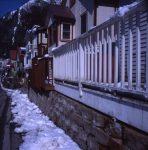 Prototyping Tl120-55 – When I got my TL120-55 lens boards back, I mounted a set of lenses on it as best I could and set out to find a suitable test subject. This receding line of houses and railings was my choice. There was lots of depth, good light, and an abundance of textures. After studying it for lens and camera defects, the image really began to grow on me. I pulled it back out because emerging from Covid feels (to me) a bit like melting out of a snowy winter.
Prototyping Tl120-55 – When I got my TL120-55 lens boards back, I mounted a set of lenses on it as best I could and set out to find a suitable test subject. This receding line of houses and railings was my choice. There was lots of depth, good light, and an abundance of textures. After studying it for lens and camera defects, the image really began to grow on me. I pulled it back out because emerging from Covid feels (to me) a bit like melting out of a snowy winter.
It is a quintessential Juneau scene. A row of company cabins, set on the mountain side, each having been modified by different owners over the years. The tight-fitting porches with their mildewing railings, the scrape of snow we hope will melt soon, and the road diving before climbing back up the ridge on the other side.
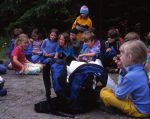 Story Time With Linda – This image captures 1st and 2nd graders, trailside for a snack and story break. Those children are now grown, and to the best of my knowledge they all survived the year just past. Having watched them all mature through the years, I can say you’re looking at nurses, ballerinas, musicians, geologists, biologists, paramedics, Broadway performers, and smoke jumpers. And I don’t think you can tell from that image who went down which path. (Probably taken with my Sputnik as no one had a TL120-1 in 2005.)
Story Time With Linda – This image captures 1st and 2nd graders, trailside for a snack and story break. Those children are now grown, and to the best of my knowledge they all survived the year just past. Having watched them all mature through the years, I can say you’re looking at nurses, ballerinas, musicians, geologists, biologists, paramedics, Broadway performers, and smoke jumpers. And I don’t think you can tell from that image who went down which path. (Probably taken with my Sputnik as no one had a TL120-1 in 2005.)
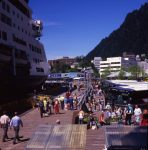 Satendam – And finally, an image of what we didn’t see in the year just past. We didn’t see security fencing, rows and rows of diesel buses, or thousands of disembarking passengers each day. We had days as sunny and glorious as this, but they were quieter with far less competition for the space and beauty. I expect 2022 will see the buses back in force, and the town again shaded by ships. I suspect we’ll be ready for it. (Rolleidoscop)
Satendam – And finally, an image of what we didn’t see in the year just past. We didn’t see security fencing, rows and rows of diesel buses, or thousands of disembarking passengers each day. We had days as sunny and glorious as this, but they were quieter with far less competition for the space and beauty. I expect 2022 will see the buses back in force, and the town again shaded by ships. I suspect we’ll be ready for it. (Rolleidoscop)
If the Juneau tourists get a bus to the Mendenhall Glacier, a mile long walk along the willows on the lake shore will bring them to the bottom of Nugget Creek. It offers a nice waterfall, and good view of the glacier.We’ve been here before.
And if one walks several miles up the “left” side of the lake, and climbs a little, it is much quieter and less crowded. Not many unguided tourists make it this far up the trail, so when I meet one I try to make them feel welcome. If the lenses in your viewer are good, you can see the crowd of tourists on the beech at the base of the waterfall.
Twenty years ago, all the open water in both images was ice. The face of the glacier was just past the rightmost iceberg in the second image. At that time, the bedrock was below more than 100′ of ice, and Nugget Falls disappeared under the edge of the glacier.
Both images are from my TL120, Nugget Falls has been captured with Kodak E100G rather than my usual Provia.
Juneau is historically a gold town. More recently, it is a tourist town. On a ‘good’ day, cruise ships can deliver more than 15,000 passengers to shore. And when all those people get ashore, they need to find something to do. Most of the ships work hard to sell package tours on board to their captive audience, but there are still folks on the sidewalks ready to help put tourists on buses out to the glacier or to another dock where they can grab a whale-watch tour.
Most of the vendors are seasonal workers. They arrive from Outside at the start of the season, rent their booth, and sell tours on commission. They’re assertive, but friendly. I’m not often mistaken for a tourist (wrong clothing and not enough tan), but when I am I listen to their pitch before turning them down.
Both of these are from my TL120 on Provia.
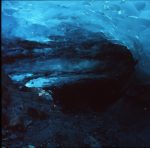 As a bonus image, I’m including a little bit of blue. Like all of my under-glacier images, the light is dim and the location is long gone.
As a bonus image, I’m including a little bit of blue. Like all of my under-glacier images, the light is dim and the location is long gone.
I’m standing in the stream which has cut its way under the ice. The ground is gravel over bedrock, and the deeper one goes the thicker the layer of gravel is. By this point, the gravel is thick enough so the stream is completely contained in the gaps between the stones. The running water carries heat under the ice which creates a gap. Then warm air start to move through and widen the gaps. The color variation in the ceiling is from the variation in thickness and sand content.
I’ve tried several times to try to duplicate this image by print and by film. In call cases, the color reproduction has stymied me. The colors reproduced by the film are not easily obtainable in any of the ink or film-recorder color spaces I’ve tried. I’ll try again in a few more years. Until then, please enjoy this original with all of its subtle colors.
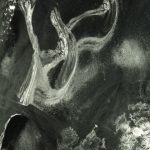 The Mendenhall is magnificent from a distance. It is spectacular if you can get up close and personal.
The Mendenhall is magnificent from a distance. It is spectacular if you can get up close and personal.
The ice has layers and threadsof dirt and sand which were washed down and embedded in the originating snow. As the glacier is pushed down the valley, the face melts away and the embedded dirt, sand, sticks, leaves, and silt are released. You should be suspicious of anyone selling you “crystal clear glacier ice” 🙂
Tripod mounted TL120-1, DR5-processed HP5
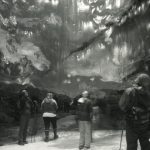 There are often caves in and under the Mendenhall glacier. In the winter, when the lake is frozen and travel is easier, there are often many folks visiting.
There are often caves in and under the Mendenhall glacier. In the winter, when the lake is frozen and travel is easier, there are often many folks visiting.
On this particular day, I set my camera up and loitered in the corner. The first set of bystanders is always very self conscious and makes explicit efforts to stay away and not “spoil” the shot. By simply loitering with a long cable release (while wearing warm clothes), I out-wait them and they are replaced. The newcomers ignore me as part of the landscape. Then I can trip the shutter, and reach over to advance the film.
Tripod mounted TL120-55. DR5-processed HP5
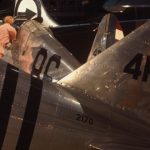 This is an interior, available-light image from the National Museum of the U.S. Air Force in Dayton. All those aluminum surfaces were just begging to be captured in stereo. The farthest tail looks to me like a B29, but I didn’t take notes about the fighters in the foreground. Can anyone identify them for us?
This is an interior, available-light image from the National Museum of the U.S. Air Force in Dayton. All those aluminum surfaces were just begging to be captured in stereo. The farthest tail looks to me like a B29, but I didn’t take notes about the fighters in the foreground. Can anyone identify them for us?
Available light, tripod mounted Canon 7D. Digital to film transfer done by Gamma Tech in New Mexico. Yes, I know I mounted it backwards 🙁
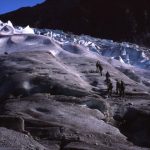 The Mendenhall glacier is in a National Forest, so commercial exploitation is expected and encouraged. One business here hikes you to the ice. There, you don crampons and helmets before setting off on an ice-trek. Four hours earlier, these folks were probably disembarking from their cruise ship. Now they’re on the glacier and about to practice their fall-arrests.
The Mendenhall glacier is in a National Forest, so commercial exploitation is expected and encouraged. One business here hikes you to the ice. There, you don crampons and helmets before setting off on an ice-trek. Four hours earlier, these folks were probably disembarking from their cruise ship. Now they’re on the glacier and about to practice their fall-arrests.
This is a cool place to live.
Tripod mounted TL120-1, most likely done on Provia 100.
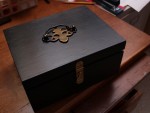 Let it be known that in the spring of the year 2016, MF3D Folio B was merged into Folio A. It came close to happening in 2008, but we got eight more years out of ‘er and it was a good run. I’ve built a new, larger box to house our combined works.
Let it be known that in the spring of the year 2016, MF3D Folio B was merged into Folio A. It came close to happening in 2008, but we got eight more years out of ‘er and it was a good run. I’ve built a new, larger box to house our combined works.
Some images from the last round of B were moved into A. These were re-labeled as such on these pages and are included in the Folio A category. A handful of images from the last round of B were returned to the artist under separate cover. These remain listed here in under Folio B.
Juneau is a gold mining town. 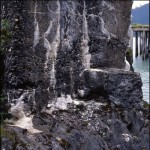 Every where you turn, you find remnants of the placer and hard-rock mining. South of Juneau, a pier stand abandoned in the water. Its pilings are bleached and trees grow from its surface. On the shore stand the pillars which supported the rail-line out to the pier.
Every where you turn, you find remnants of the placer and hard-rock mining. South of Juneau, a pier stand abandoned in the water. Its pilings are bleached and trees grow from its surface. On the shore stand the pillars which supported the rail-line out to the pier.
When it was a working facility, the ships from Seattle would dock here in Dupont to offload their cargo of dynamite. It would be trundled down the rail-line to an elevated warehouse along the shore. From there, smaller loads would be transported by boat to the mines in Treadwell, Douglas, and Juneau.
Excepting the iron bits, the pier, dock, and warehouse were built from local materials. This image may be better named, Flowers From Stone, as the concrete is covered with the efflorescence from the beach sand and gravel.
I tried to set the focus and aperture to let the distant pier fall out of focus. I think I could have opened the aperture a bit more.
Once again, I’m chasing the retreating ice.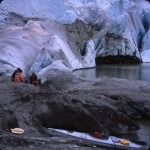 More often than not, there is now a kayak pulled up on the rocks after I’ve walked all the way out. It would be a lot quicker way to arrive than on foot!
More often than not, there is now a kayak pulled up on the rocks after I’ve walked all the way out. It would be a lot quicker way to arrive than on foot!
In this case, this group arrived in a pair of kayaks and settled in for lunch before doing their exploring. The “rock” they are on is actually a gravel-covered block of ice. The ice will melt over the next couple of months, leaving only a pile of sand and gravel. The fall rains and winter snow will probably wash the remaining sand down into the lake by spring.
The area of darkened ice on the face of the glacier is an area where the under-ice river flows out into the lake. The in-rushing water is leaving ripples in the otherwise still lake.
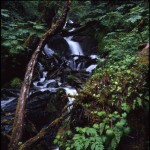 You might be tempted to misidentify this as your basic, Southeast Alaska, rainforest stream. There are so many of them, it’s hard to get anywhere without having to find your way across a couple dozen of them. But this, I’m sure, is the home of an elusive Water Nymph. I’ve tried numerous times to catch a glimpse, but I’m always disappointed. I probably make so much noise getting through the undergrowth, that she’s able to make herself scarce before I arrive.
You might be tempted to misidentify this as your basic, Southeast Alaska, rainforest stream. There are so many of them, it’s hard to get anywhere without having to find your way across a couple dozen of them. But this, I’m sure, is the home of an elusive Water Nymph. I’ve tried numerous times to catch a glimpse, but I’m always disappointed. I probably make so much noise getting through the undergrowth, that she’s able to make herself scarce before I arrive.
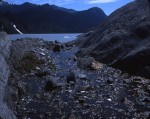 In the summer of 2015, I did another long walk looking for tripod holes. I load my pack with a TL120, a digital SLR, maybe a W1, a box of slides, and a STL viewer. The task is to find the locations, and recreate the view. The challenge is to make an engaging image in a location which probably no longer has the jaw dropping magnificence of its youth.
In the summer of 2015, I did another long walk looking for tripod holes. I load my pack with a TL120, a digital SLR, maybe a W1, a box of slides, and a STL viewer. The task is to find the locations, and recreate the view. The challenge is to make an engaging image in a location which probably no longer has the jaw dropping magnificence of its youth.
It is hard to suppress the cringing and pain I feel as I search for tripod holes. I have a visual memory. My trek across the barren rock is a long slow playback of previous excursions, narrated by my little voice, “I remember when . . .”, “We forded the stream up there . . . “, “This used to be . . .”.
This location happens to be where 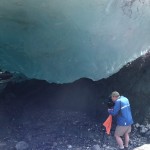 I made some of my favorite images. I know one made it into the folio. Others, including Raining Tunnel, made their way into a slide display at the NSA convention in Colorado. The camera location recorded in this thumbnail (from 2010) is just about where the cliff wall exits the right side of the stereo view. In this case, I was unable to create any meaningful image by putting my tripod back into those holes. I chose, instead, to move my camera to the vantage point from which I had made the 2010 self-image.
I made some of my favorite images. I know one made it into the folio. Others, including Raining Tunnel, made their way into a slide display at the NSA convention in Colorado. The camera location recorded in this thumbnail (from 2010) is just about where the cliff wall exits the right side of the stereo view. In this case, I was unable to create any meaningful image by putting my tripod back into those holes. I chose, instead, to move my camera to the vantage point from which I had made the 2010 self-image.
In 2010, the water ran into a ice tunnel of uncertainty and opportunity. I knew it fell into the lake somewhere, but how far would I venture into that tunnel to find and capture images. In 2015, it is a spread of certainty. The fireweed and willow have taken root, the stream runs in the open, and a Southeast rain forest will soon own this location.